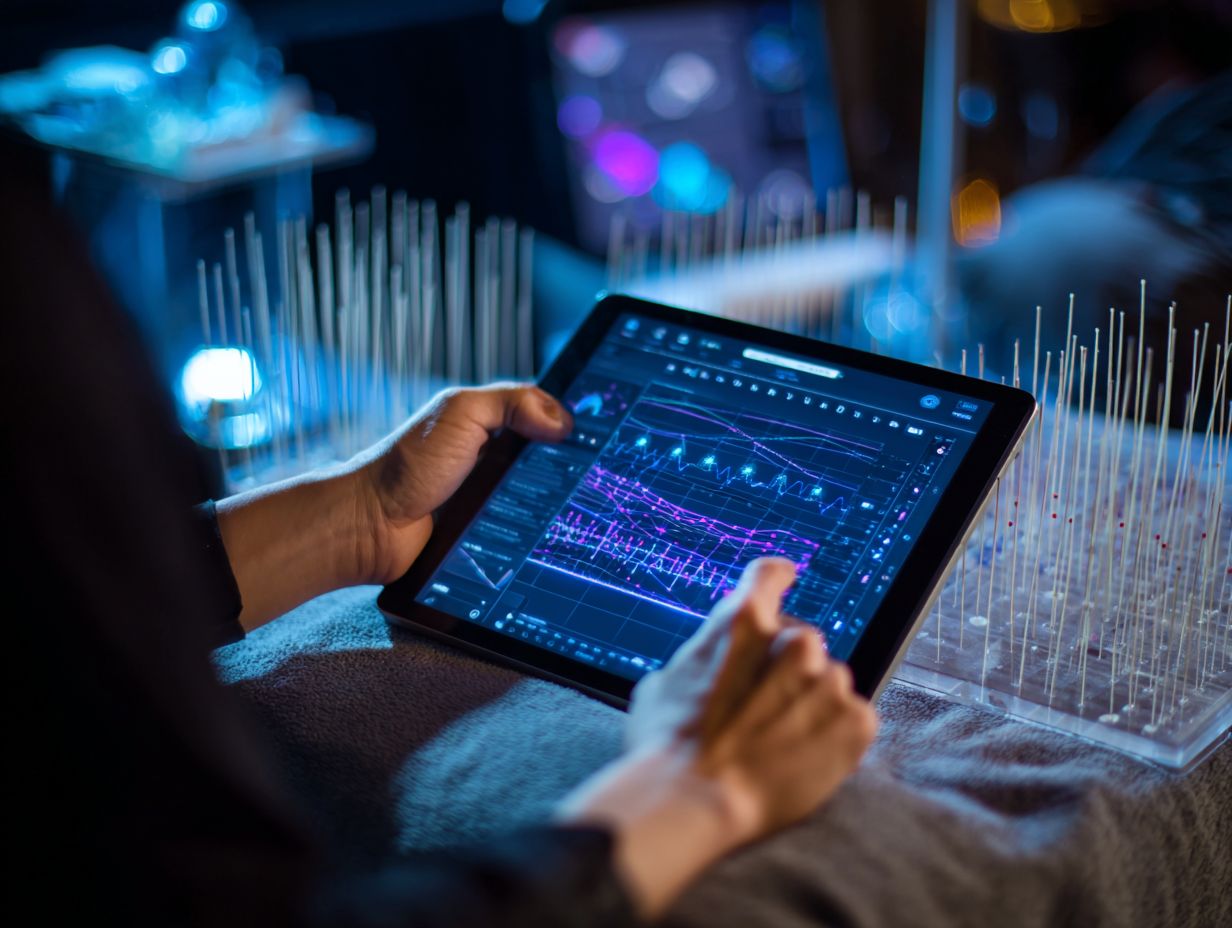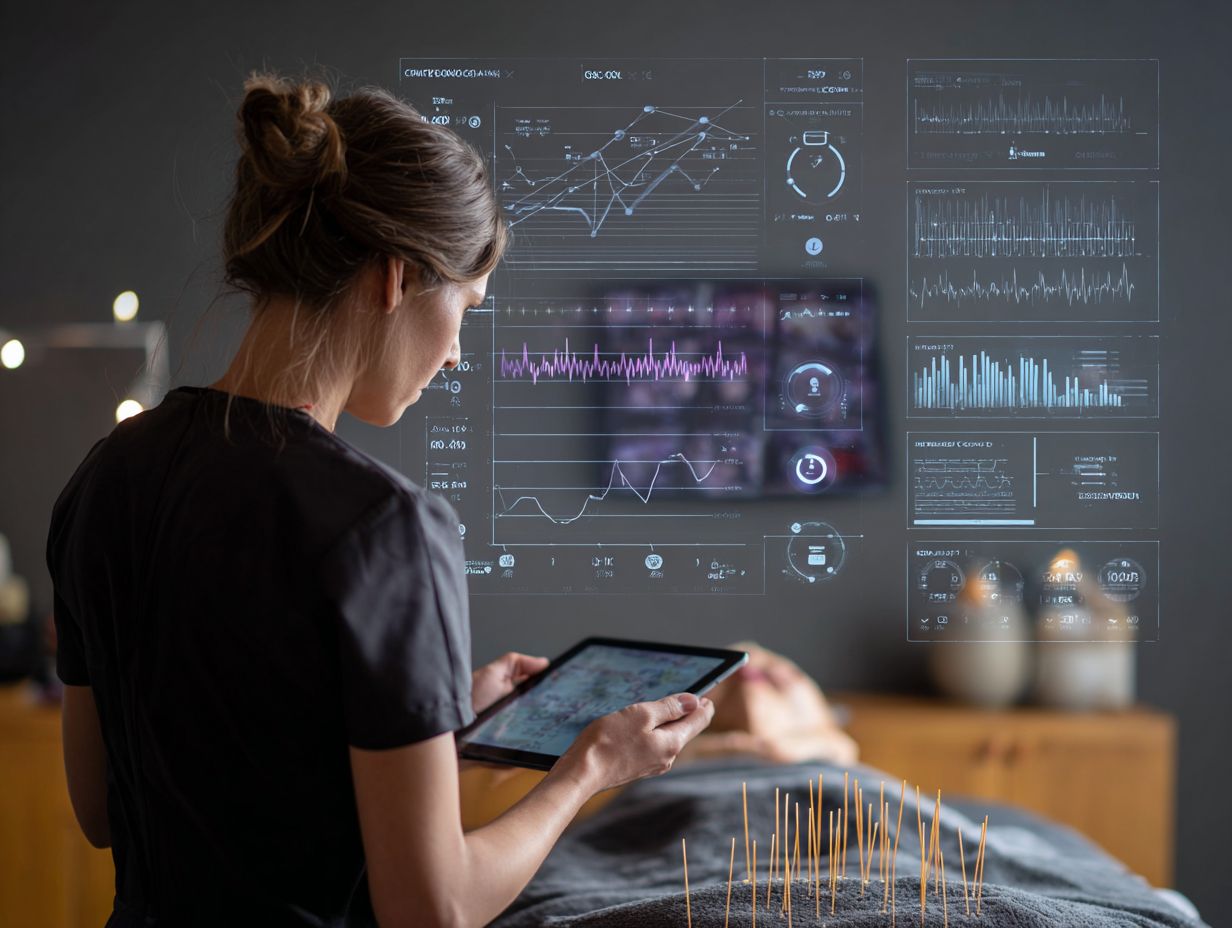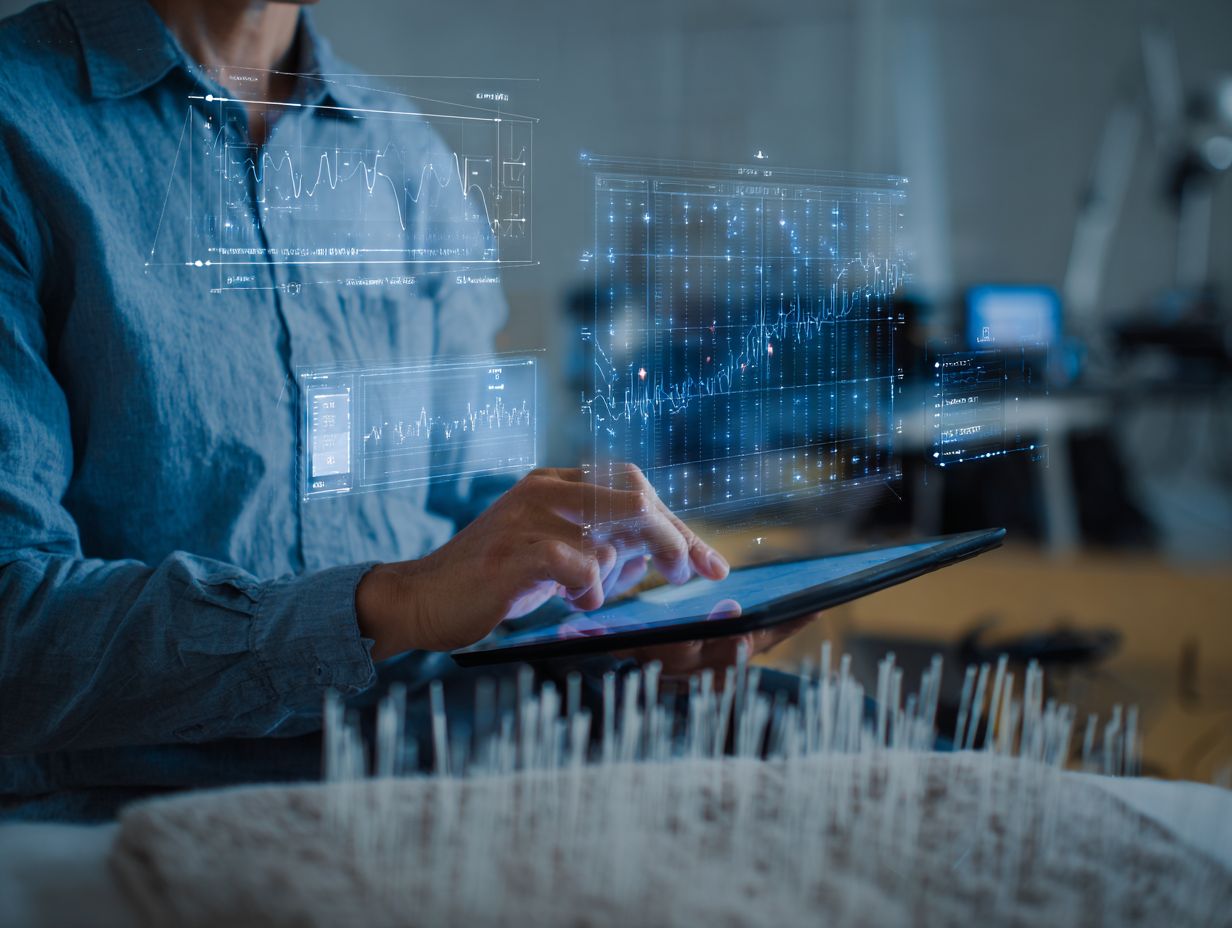Machine Learning in Acupuncture: Innovations
Contents
- 1 Introduction to Machine Learning in Acupuncture
- 2 Historical Context
- 3 Current Innovations in Machine Learning
- 4 Benefits of Machine Learning in Acupuncture
- 5 AI-Directed Acupuncture Statistics
- 5.1 AI and Acupuncture: AI Applications in Acupuncture
- 5.2 AI and Acupuncture: Pain-Related Disease Acupuncture Studies
- 5.3 AI and Acupuncture: Acupuncture Point Selection
- 5.4 AI and Acupuncture: Acupuncture Databases and Analysis
- 5.5 Improved Diagnosis Accuracy
- 5.6 Personalized Treatment Plans
- 5.7 Enhanced Patient Monitoring
- 6 Challenges and Limitations
- 7 Future Directions
- 8 Frequently Asked Questions
- 8.1 What is machine learning in acupuncture and how is it being used for innovations?
- 8.2 How does machine learning in acupuncture work?
- 8.3 What are some of the innovations in machine learning for acupuncture?
- 8.4 Can machine learning in acupuncture improve patient outcomes?
- 8.5 Are there any risks or limitations to using machine learning in acupuncture?
- 8.6 How can machine learning in acupuncture benefit traditional acupuncture practices?
Introduction to Machine Learning in Acupuncture
 Combining acupuncture with new machine learning technology can improve patient care. By using artificial intelligence and deep learning tools, experts can create medical plans customized for each person’s requirements. Analyzing language helps improve data review, which results in better diagnosis and treatment results. Learn how new technologies are improving acupuncture and enhancing natural healing practices.
Combining acupuncture with new machine learning technology can improve patient care. By using artificial intelligence and deep learning tools, experts can create medical plans customized for each person’s requirements. Analyzing language helps improve data review, which results in better diagnosis and treatment results. Learn how new technologies are improving acupuncture and enhancing natural healing practices.
Key Takeaways:
Overview of Acupuncture
Acupuncture is a core component of traditional Chinese medicine that employs the stimulation of acupoints to promote healing and balance in the body.
This therapy is based on the idea that the body’s energy, known as Qi, moves through certain routes called meridians.
During treatment, practitioners carefully select acupoints based on an individual’s symptoms and overall constitution. For instance, to alleviate stress, they might stimulate points like LI4 (Hegu) and PC6 (Neiguan), which are known for calming the mind.
Acupuncture can help with different problems like pain or digestive issues by focusing on specific points, offering a customized method for recovery. For those interested in a comprehensive overview, this analysis by UCLA Health covers the foundational aspects of Traditional Chinese Medicine, enhancing understanding of its principles and applications. To delve deeper into acupuncture’s benefits in relieving pain, consider exploring this comprehensive patient guide.
What is Machine Learning?
Machine learning is a subset of artificial intelligence that focuses on the development of algorithms that enable computers to learn from and make predictions based on data.
At its core, machine learning involves three key components: algorithms, data processing techniques, and predictive modeling.
Algorithms, such as decision trees or neural networks, are designed to identify patterns within data sets. Methods like normalization and feature selection process raw data into formats suitable for analysis. According to a discussion by IBM, these algorithms play a critical role in transforming raw data into actionable insights.
Predictive modeling uses past data to predict outcomes. This is useful in clinical validation, where it can improve diagnosis accuracy and treatment effectiveness by looking at patient data patterns.
Historical Context
Studying the history of acupuncture and technology shows how treatment methods have changed from ancient practices to current uses.
Traditional Techniques in Acupuncture
Traditional acupuncture techniques, grounded in the theory of Zheng patterns, rely on time-tested practices and TCM instruments for diagnosis and treatment.
Practitioners assess patient demographics and specific conditions by employing evidence-based methodologies, such as pulse and tongue diagnosis. Pulse diagnosis checks the rate and the quality of the pulse to find any imbalance.
Practitioners may review medical histories and lifestyle factors, incorporating modern assessment tools like standardized questionnaires. This approach offers customized treatments that address issues like ongoing pain or digestive problems effectively.
By using traditional methods along with modern information, acupuncturists improve how well they can diagnose and treat patients.
Early Adoption of Technology in Medicine
The integration of technology in medicine began with simple medical devices and gradually evolved to complex systems that analyze patient demographics and treatment outcomes.
Initially, tools like the stethoscope and X-ray machines laid the groundwork for data collection in clinical settings. These innovations improved the accuracy of medical tests and highlighted the role of data in treating patients.
Over the years, this evolved into sophisticated electronic health records (EHRs) that aggregate information such as treatment history and lab results. Today, machine learning algorithms analyze this vast amount of data, enabling predictive analytics that help tailor individual treatment plans. As the Wikipedia timeline of medical technology illustrates, these advancements build upon decades of innovation.
This change makes clinical trials work better and helps patients by using current information to make choices. One of our hidden gems on acupuncture mechanisms provides insights into how traditional methods are enhanced by modern electronic tools.
Current Innovations in Machine Learning
Recent progress in machine learning is changing acupuncture by using improved methods for gathering data and complex algorithms such as convolutional neural networks.
Data Collection Techniques
Effective data collection methods in acupuncture use data mining and real-time monitoring to collect detailed patient information.
Surveys are often used to gather detailed information about patients’ experiences and results from treatments, offering useful feedback for better clinical practices.
Neuroimaging biomarkers, like fMRI and EEG, can assess neurological changes during treatments, offering objective evidence of acupuncture’s effects.
Patients can use mobile apps or diaries to record their pain and feelings, providing doctors with important details for customized care.
Using these methods improves knowledge of how well treatments work and how happy patients are.
Algorithms Used in Acupuncture

Machine learning in acupuncture uses various algorithms, like transformer-based models, to make better predictions and improve patient treatment plans.
For instance, regression algorithms can analyze historical patient data to identify trends in symptoms and response to treatments, thereby improving treatment plans.
Reinforcement learning is important because it changes treatment plans based on immediate feedback from patients, improving results over time.
Clustering algorithms can categorize patients with similar conditions, allowing practitioners to customize their approaches effectively.
By using these machine learning models, acupuncturists can predict patient needs and improve the overall treatment experience.
Case Studies: Successful Implementations
Real-world case studies demonstrate the successful implementation of machine learning in acupuncture, showcasing its effectiveness in predictive modeling and clinical validation.
For instance, a study at a San Francisco clinic used machine learning algorithms to analyze patient data and predict treatment outcomes for chronic pain patients. By integrating patient history, demographics, and response patterns, they achieved a 30% increase in treatment success rates.
Another case involved a Beijing hospital employing AI to tailor acupuncture points based on real-time patient feedback, resulting in improved patient satisfaction scores.
These strategies improved clinical results and made better use of resources, highlighting the strong impact of machine learning on regular methods.
Benefits of Machine Learning in Acupuncture
Machine learning makes acupuncture better by helping create accurate diagnoses and personalized treatment plans for each patient.
AI-Directed Acupuncture Statistics
AI-Directed Acupuncture Statistics
AI and Acupuncture: AI Applications in Acupuncture
AI and Acupuncture: Pain-Related Disease Acupuncture Studies
AI and Acupuncture: Acupuncture Point Selection
AI and Acupuncture: Acupuncture Databases and Analysis
The integration of AI into acupuncture practice, as reflected in the AI-Directed Acupuncture Statistics, showcases significant advancements in predictive accuracy and treatment efficacy. This dataset provides information on different AI uses in acupuncture, focusing on forecasting treatment results and improving therapy methods.
AI Applications in Acupuncture demonstrate remarkable accuracies, with machine learning-based efficacy prediction models achieving an 84% accuracy rate. AI can predict treatment outcomes accurately, helping doctors design more effective personalized treatment plans. Moreover, neuroimaging-based models AI achieves 92.14% accuracy, showing its ability to use detailed neural data in acupuncture methods. The video-based acupuncture manipulation classification AI reaches a 95.4% accuracy, showing it can accurately study and organize acupuncture methods, improving education and uniformity in how practitioners use them.
In pain-related disease acupuncture studies, AI models show substantial prediction accuracies for various conditions. For Migraine Without Aura (MwoA), the model reaches an 84% accuracy, while for Chronic Low Back Pain (cLBP), it records an 83% accuracy. However, the accuracy decreases to 70% for Primary Dysmenorrhea (PDM) AI models work well, but sometimes there’s a need to improve predictive algorithms in specific situations.
The acupuncture point selection data notes that while there are 361 total acupoints in the human body, only a select few are commonly used for specific conditions- 3 acupoints each for dysmenorrhea and epilepsy treatment. This highlights how AI can improve acupoint selection for better treatment results, making the process more effective.
Furthermore, acupuncture databases and analysis involve a blend of Chinese (4) and English (6) database sources, facilitating cross-cultural research and knowledge exchange. The use of 2 commonly used Apriori model parameters highlights the careful method used to examine acupuncture data, which probably helps find patterns and links in how well treatments work.
To sum up, using AI in acupuncture, as demonstrated by these statistics, offers new chances to make treatments more accurate, gain scientific validation of acupuncture methods, and create personalized healthcare solutions.
Improved Diagnosis Accuracy

Using information from data, machine learning can improve diagnosis accuracy in acupuncture, possibly raising it from 70% to more than 90% in certain situations.
This improvement is achieved through the analysis of extensive historical patient data, where machine learning algorithms identify patterns correlating symptoms with treatment outcomes.
For instance, tools like TensorFlow or Scikit-learn can be employed to develop predictive models that analyze patient demographics, treatment types, and recovery rates.
A study revealed that when machine learning was applied to historical treatment data, predictive accuracy for patient outcomes increased by 25%, significantly outperforming traditional diagnostic methods.
This data-focused method improves acupuncture techniques and helps practitioners tailor treatments more effectively.
Personalized Treatment Plans
Machine learning helps develop individualized treatment plans by examining data from different patient groups and adjusting treatments to fit their needs.
By incorporating factors such as patient history, demographics, and treatment responses, machine learning algorithms can identify patterns that traditional methods may overlook.
For instance, a model might analyze electronic health records to determine how similar patients responded to particular medications. IBM Watson and Google Health use this technology to recommend therapy options personalized to each person, based on thorough data input.
Doctors can use this information to tailor patient treatment plans, which may lead to better results and fewer negative effects.
Enhanced Patient Monitoring
Machine learning in patient monitoring helps doctors get instant feedback on how treatments are working and change care plans as needed.
To implement effective monitoring, healthcare providers can use platforms like IBM Watson Health or Google Cloud Healthcare, which analyze patient data in real-time.
Gathering patient feedback through mobile apps or surveys provides a more complete view of treatment progress.
Using a symptom tracking app lets patients enter their daily symptoms, which helps doctors quickly modify medications or treatments based on patterns in the data.
This active method improves personal care and makes general results better.
Challenges and Limitations
Although machine learning can be useful in acupuncture, it faces obstacles like data privacy issues and needing to blend with traditional methods.
Data Privacy Concerns
Data privacy concerns arise when collecting patient information, highlighting the importance of regulatory compliance and ethical considerations in machine learning applications.
To deal with these issues, professionals should follow some recommended practices.
- Begin by ensuring compliance with HIPAA by reviewing your procedures frequently and training your team on proper data management.
- Second, use encryption tools like Veracrypt to protect stored patient data.
- Third, anonymize data where possible to protect patient identities during analysis.
Develop simple patient agreement steps that clearly explain the use of data, promoting openness and confidence. These steps protect patient privacy and make data-based healthcare improvements safer.
Integration with Traditional Practices
Integrating machine learning with traditional acupuncture practices presents challenges, as it requires balancing modern evidence-based practices with historical healing methods.
Practitioners can begin by using machine learning to examine patient information, finding patterns that guide treatment plans while honoring traditional Chinese medicine (TCM) principles.
For example, tools like IBM Watson Health can process vast amounts of health data, suggesting acupuncture points based on symptoms observed in similar populations.
Think about working together with data scientists to create specific algorithms that improve diagnostic accuracy while preserving the details of TCM.
Regularly discuss with experienced acupuncturists to ensure technology does not alter essential healing techniques.
Need for Standardization
Having uniform standards in machine learning applications is important for consistent clinical practices and treatment protocols in acupuncture settings.
Setting up standard procedures can greatly improve patient care and make practices more efficient.
For instance, adopting a uniform data collection method allows for better analysis of treatment effectiveness. Tools like REDCap can facilitate structured data entry, ensuring consistent patient information.
Following rules for machine learning models, like using consistent input variables, can improve how well models work and how easily they can be repeated.
By encouraging teamwork among practitioners, sharing data becomes easier, leading to more trustworthy information on effective acupuncture methods.
Future Directions
Machine learning in acupuncture has great potential, offering many chances for research and cooperation between acupuncture experts and data scientists.
Potential Research Areas

Key potential research areas in machine learning and acupuncture include predictive analytics, treatment optimization, and larger scale clinical trials.
Each area holds significant promise. Predictive analytics, for instance, can analyze patient data to forecast treatment responses, allowing practitioners to tailor their approaches.
Treatment improvement uses algorithms to evaluate results and improve methods, which can increase patient satisfaction and effectiveness.
Larger scale clinical trials using machine learning can identify patterns across diverse populations, thereby improving the generalizability of findings.
By exploring these options, researchers can improve clinical practices and help explain how acupuncture works and its benefits.
Collaboration Between Practitioners and Data Scientists
Working together, acupuncture experts and data scientists can create machine learning models that address patient needs well.
Doctors and analysts can create specific treatment plans based on the patient’s information by working together.
For example, data scientists can study patient histories to find patterns, helping acupuncturists improve their methods. Using tools like Python for data analysis and Tableau for visualization can improve knowledge of treatment outcomes.
Hosting interdisciplinary workshops can also facilitate knowledge exchange-allowing practitioners to articulate their challenges while scientists propose algorithmic solutions. This teamwork results in more flexible and accurate acupuncture methods.
Summary of Innovations
Recent advancements in machine learning offer significant benefits for acupuncture, such as improved methods for diagnosing conditions and tailoring treatments to individual needs.
Practitioners can use tools like IBM Watson Health to study patient data and improve diagnostic accuracy. By using wearable devices, they can collect real-time health data, which helps create treatment plans specific to the individual’s current needs.
For example, using the PainScale app helps doctors keep track of patient progress and adjust treatments more responsively. Websites like Coursera have classes on data analytics focused on healthcare, helping acupuncturists learn about and use these new developments well.
**Last Thoughts on What’s Next for Acupuncture**
Machine learning will likely change how acupuncture treatments are performed and how patients perceive their experiences in important ways.
For example, algorithms could analyze patient data to recommend specific acupuncture points based on individual health histories.
Tools like IBM Watson can help sort through large medical studies, giving doctors treatment choices based on solid evidence and suited to each patient.
Mobile apps could be developed for patients to log their symptoms and treatment results as they happen, giving acupuncturists useful information for continued care.
This mix of technology and age-old methods improves accuracy and patient involvement, changing acupuncture going forward.
Frequently Asked Questions
What is machine learning in acupuncture and how is it being used for innovations?
Machine learning in acupuncture is a branch of artificial intelligence that uses algorithms and statistical models to analyze acupuncture techniques and data. It is being used for innovations to improve diagnosis, treatment plans, and outcomes in acupuncture.
How does machine learning in acupuncture work?
Machine learning in acupuncture uses a combination of data and algorithms to learn patterns and make predictions based on the data. It can be used to analyze patient data, acupuncture techniques, and treatment outcomes to find patterns and improve treatment plans.
What are some of the innovations in machine learning for acupuncture?
New methods in machine learning for acupuncture use advanced algorithms to study medical images and identify small differences in acupuncture points. This helps create personalized treatment plans for each patient. Language processing is also used to review patient feedback to improve treatment methods.
Can machine learning in acupuncture improve patient outcomes?
Yes, machine learning in acupuncture has the potential to improve patient outcomes by analyzing data and finding patterns that can lead to more effective treatment plans. By using machine learning programs, healthcare professionals can develop individualized treatment plans for each patient according to their specific information and requirements.
Are there any risks or limitations to using machine learning in acupuncture?
Like any technology, there are potential risks and limitations to using machine learning in acupuncture. Some concerns include the potential for biased algorithms, limited access to data, and the need for further research and development. With careful application and supervision, the advantages of using machine learning in acupuncture can be greater than any possible downsides.
How can machine learning in acupuncture benefit traditional acupuncture practices?
Using machine learning in acupuncture can improve traditional methods by giving practitioners information based on data and customized treatment plans, resulting in more successful and quicker treatments. It can also help modernize and improve the overall quality of care in traditional acupuncture practices.

Sheetal Sharda has a background in CS. She got an interest in Holistic living back in 2018, and has since started exploring more into Naturapathy, Holistic Living, Yoga, and more. She got inspired to start SereneClinics to help people find reliable centers across the world.






